Report on Implementing Continuous Improvement Strategies at TESCO
VerifiedAdded on 2022/12/28
|9
|2629
|66
Report
AI Summary
This report provides a comprehensive analysis of continuous improvement processes, using TESCO as a case study. It explores the implementation of self-checkout systems and the resulting organizational changes. The report delves into reasons for employee resistance to change, strategies for gaining employee support (such as involvement, clear goals, and honest communication), and the application of Lewin's change management model. Furthermore, it examines monitoring tools like cause-and-effect diagrams and process mapping, along with communication strategies for outcomes. The report also discusses opportunities for improvement, including think tanks and surveys, and provides examples of continuous improvement tools like PDCA. Finally, it covers employee coaching methods and the importance of data gathering and benchmarking to ensure successful continuous improvement within TESCO. The report concludes by summarizing the key elements of continuous improvement within the context of the retail giant, emphasizing the importance of a holistic approach that integrates technological advancements with employee engagement and effective communication.
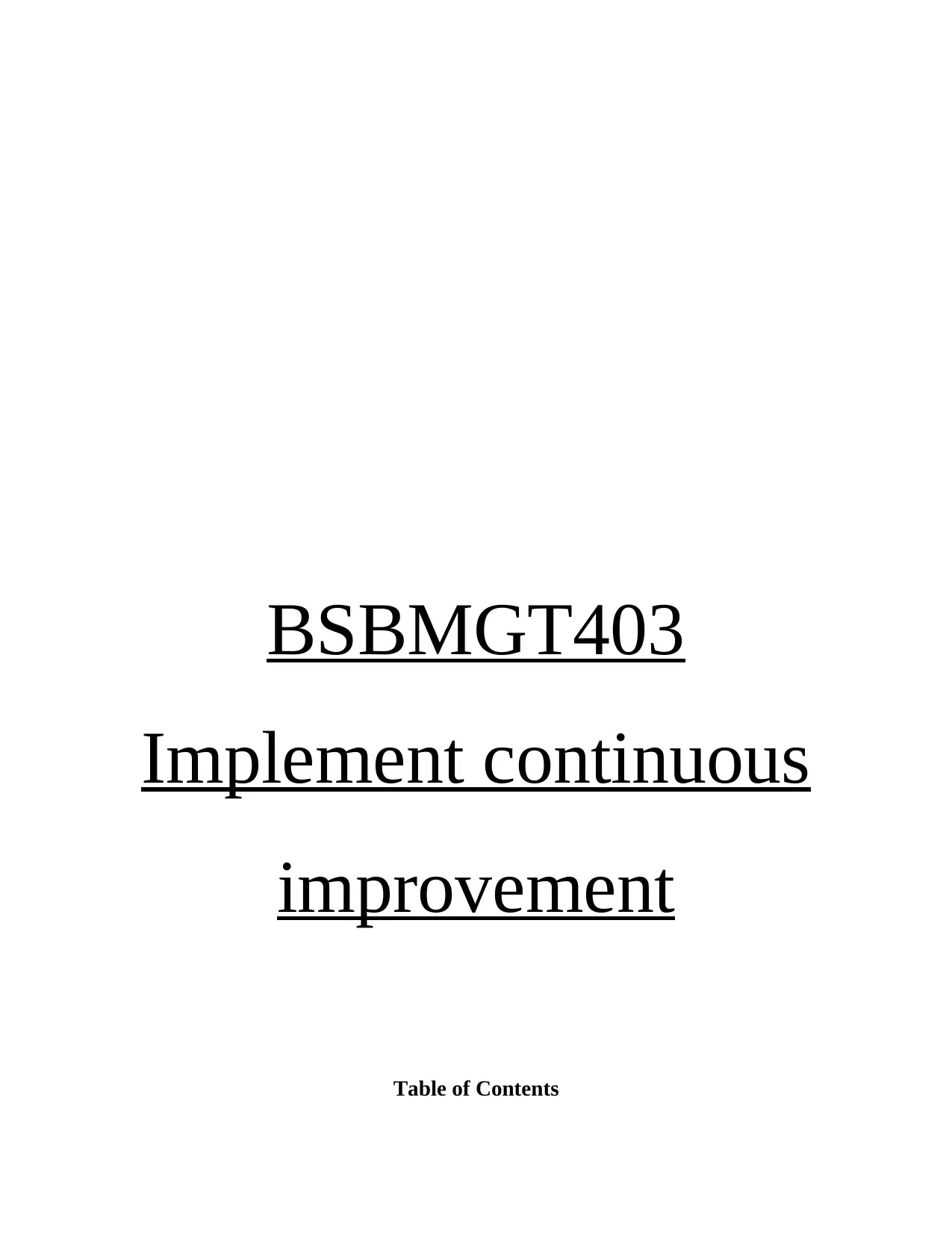
BSBMGT403
Implement continuous
improvement
Table of Contents
Implement continuous
improvement
Table of Contents
Paraphrase This Document
Need a fresh take? Get an instant paraphrase of this document with our AI Paraphraser
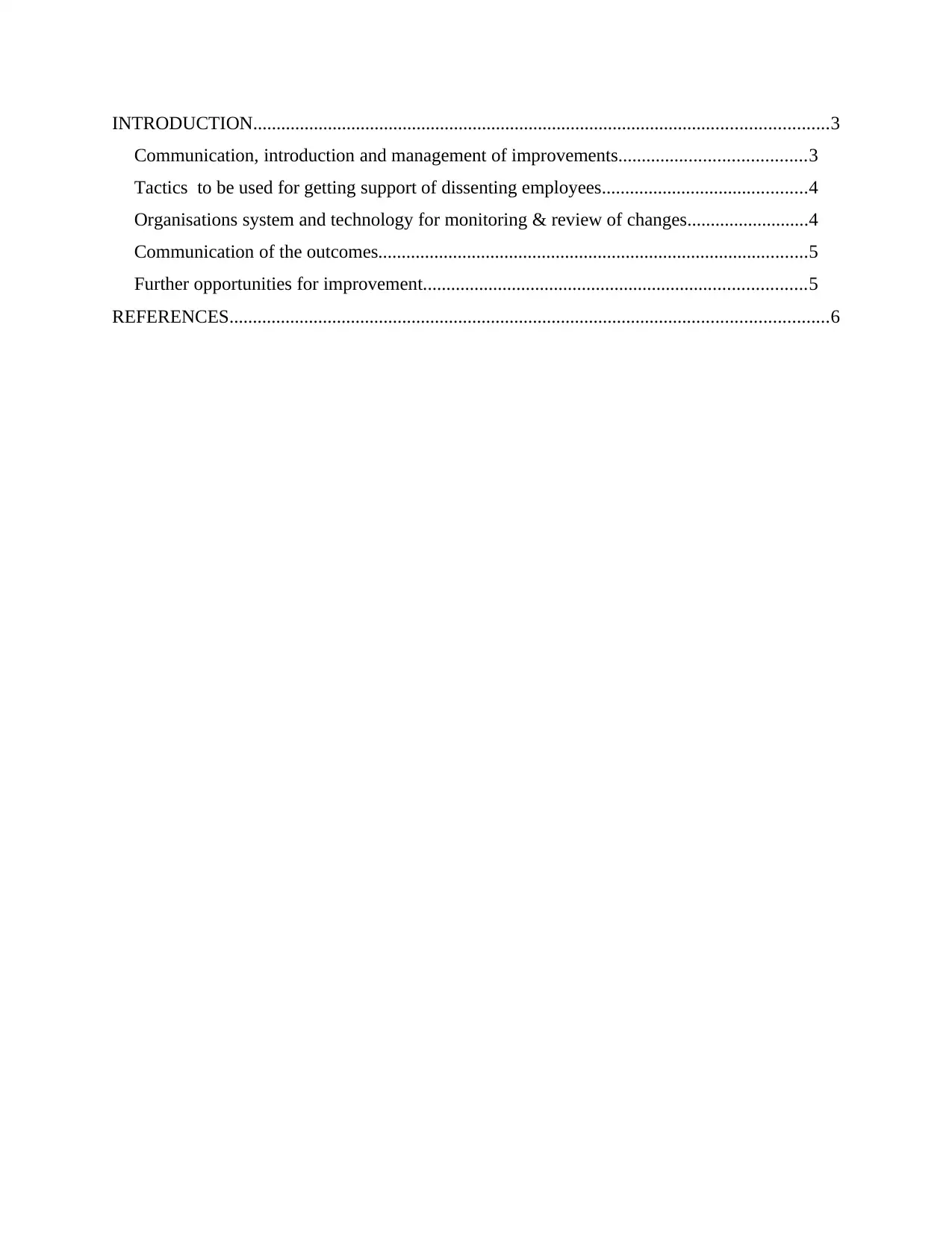
INTRODUCTION...........................................................................................................................3
Communication, introduction and management of improvements........................................3
Tactics to be used for getting support of dissenting employees............................................4
Organisations system and technology for monitoring & review of changes..........................4
Communication of the outcomes............................................................................................5
Further opportunities for improvement..................................................................................5
REFERENCES................................................................................................................................6
Communication, introduction and management of improvements........................................3
Tactics to be used for getting support of dissenting employees............................................4
Organisations system and technology for monitoring & review of changes..........................4
Communication of the outcomes............................................................................................5
Further opportunities for improvement..................................................................................5
REFERENCES................................................................................................................................6
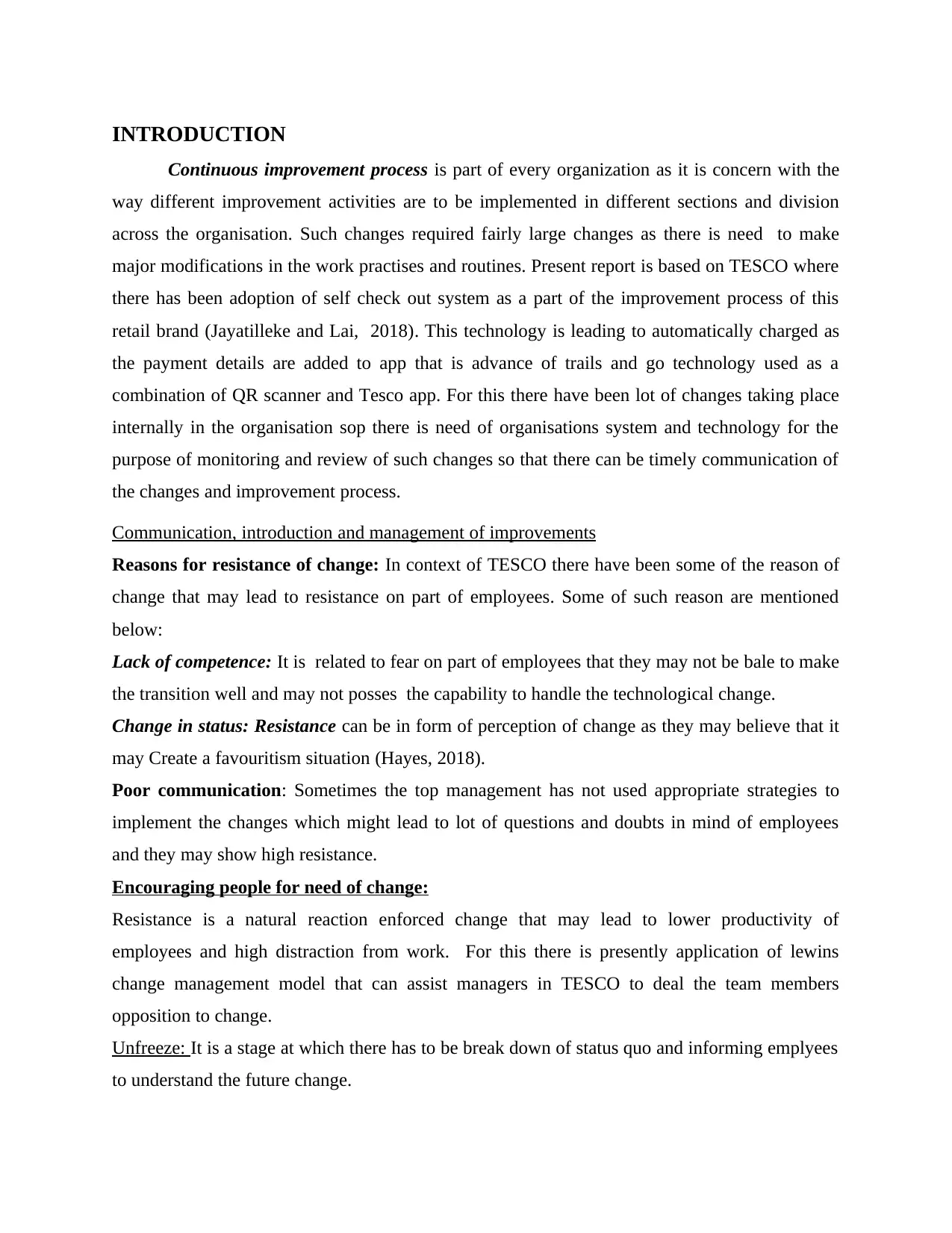
INTRODUCTION
Continuous improvement process is part of every organization as it is concern with the
way different improvement activities are to be implemented in different sections and division
across the organisation. Such changes required fairly large changes as there is need to make
major modifications in the work practises and routines. Present report is based on TESCO where
there has been adoption of self check out system as a part of the improvement process of this
retail brand (Jayatilleke and Lai, 2018). This technology is leading to automatically charged as
the payment details are added to app that is advance of trails and go technology used as a
combination of QR scanner and Tesco app. For this there have been lot of changes taking place
internally in the organisation sop there is need of organisations system and technology for the
purpose of monitoring and review of such changes so that there can be timely communication of
the changes and improvement process.
Communication, introduction and management of improvements
Reasons for resistance of change: In context of TESCO there have been some of the reason of
change that may lead to resistance on part of employees. Some of such reason are mentioned
below:
Lack of competence: It is related to fear on part of employees that they may not be bale to make
the transition well and may not posses the capability to handle the technological change.
Change in status: Resistance can be in form of perception of change as they may believe that it
may Create a favouritism situation (Hayes, 2018).
Poor communication: Sometimes the top management has not used appropriate strategies to
implement the changes which might lead to lot of questions and doubts in mind of employees
and they may show high resistance.
Encouraging people for need of change:
Resistance is a natural reaction enforced change that may lead to lower productivity of
employees and high distraction from work. For this there is presently application of lewins
change management model that can assist managers in TESCO to deal the team members
opposition to change.
Unfreeze: It is a stage at which there has to be break down of status quo and informing emplyees
to understand the future change.
Continuous improvement process is part of every organization as it is concern with the
way different improvement activities are to be implemented in different sections and division
across the organisation. Such changes required fairly large changes as there is need to make
major modifications in the work practises and routines. Present report is based on TESCO where
there has been adoption of self check out system as a part of the improvement process of this
retail brand (Jayatilleke and Lai, 2018). This technology is leading to automatically charged as
the payment details are added to app that is advance of trails and go technology used as a
combination of QR scanner and Tesco app. For this there have been lot of changes taking place
internally in the organisation sop there is need of organisations system and technology for the
purpose of monitoring and review of such changes so that there can be timely communication of
the changes and improvement process.
Communication, introduction and management of improvements
Reasons for resistance of change: In context of TESCO there have been some of the reason of
change that may lead to resistance on part of employees. Some of such reason are mentioned
below:
Lack of competence: It is related to fear on part of employees that they may not be bale to make
the transition well and may not posses the capability to handle the technological change.
Change in status: Resistance can be in form of perception of change as they may believe that it
may Create a favouritism situation (Hayes, 2018).
Poor communication: Sometimes the top management has not used appropriate strategies to
implement the changes which might lead to lot of questions and doubts in mind of employees
and they may show high resistance.
Encouraging people for need of change:
Resistance is a natural reaction enforced change that may lead to lower productivity of
employees and high distraction from work. For this there is presently application of lewins
change management model that can assist managers in TESCO to deal the team members
opposition to change.
Unfreeze: It is a stage at which there has to be break down of status quo and informing emplyees
to understand the future change.
⊘ This is a preview!⊘
Do you want full access?
Subscribe today to unlock all pages.

Trusted by 1+ million students worldwide
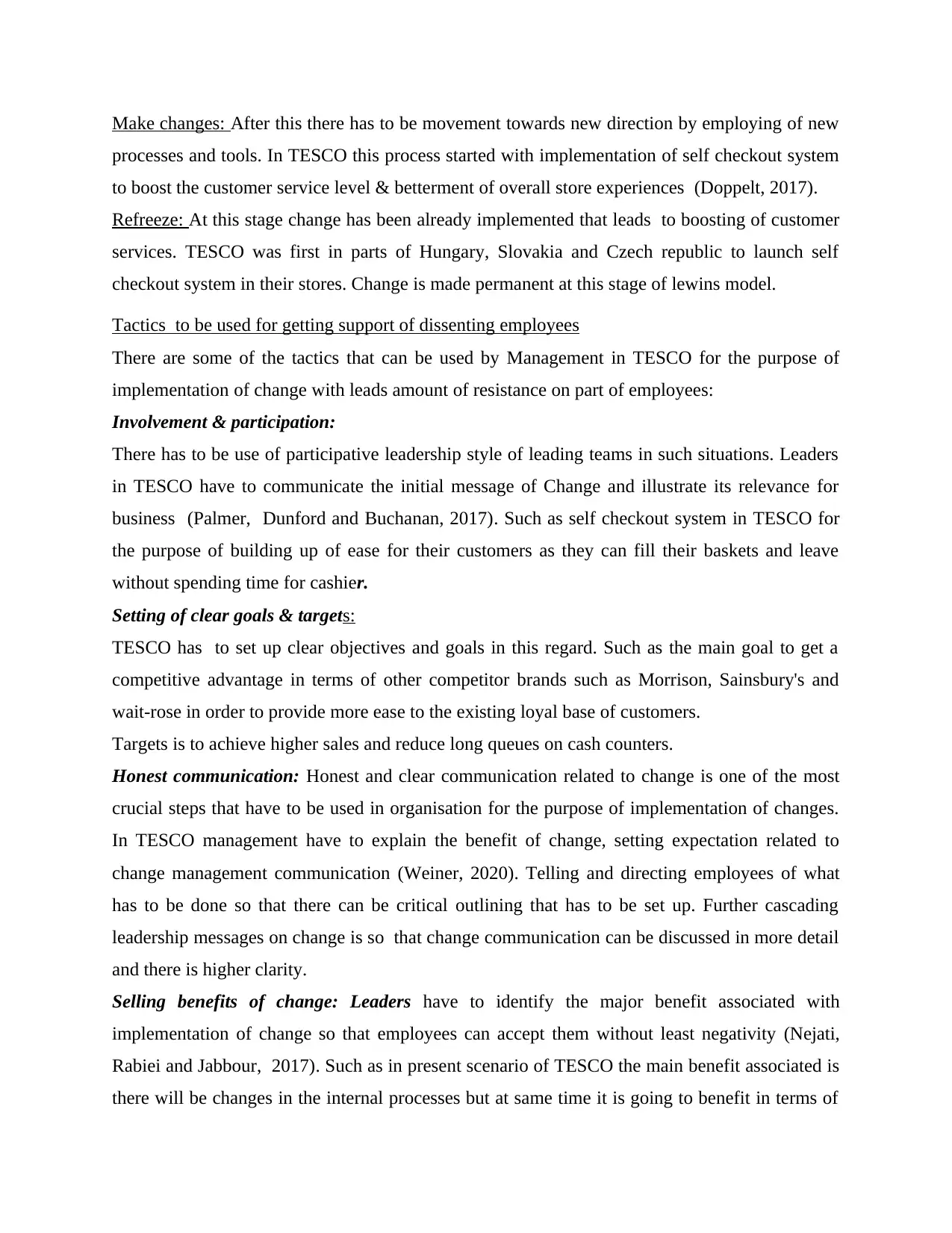
Make changes: After this there has to be movement towards new direction by employing of new
processes and tools. In TESCO this process started with implementation of self checkout system
to boost the customer service level & betterment of overall store experiences (Doppelt, 2017).
Refreeze: At this stage change has been already implemented that leads to boosting of customer
services. TESCO was first in parts of Hungary, Slovakia and Czech republic to launch self
checkout system in their stores. Change is made permanent at this stage of lewins model.
Tactics to be used for getting support of dissenting employees
There are some of the tactics that can be used by Management in TESCO for the purpose of
implementation of change with leads amount of resistance on part of employees:
Involvement & participation:
There has to be use of participative leadership style of leading teams in such situations. Leaders
in TESCO have to communicate the initial message of Change and illustrate its relevance for
business (Palmer, Dunford and Buchanan, 2017). Such as self checkout system in TESCO for
the purpose of building up of ease for their customers as they can fill their baskets and leave
without spending time for cashier.
Setting of clear goals & targets:
TESCO has to set up clear objectives and goals in this regard. Such as the main goal to get a
competitive advantage in terms of other competitor brands such as Morrison, Sainsbury's and
wait-rose in order to provide more ease to the existing loyal base of customers.
Targets is to achieve higher sales and reduce long queues on cash counters.
Honest communication: Honest and clear communication related to change is one of the most
crucial steps that have to be used in organisation for the purpose of implementation of changes.
In TESCO management have to explain the benefit of change, setting expectation related to
change management communication (Weiner, 2020). Telling and directing employees of what
has to be done so that there can be critical outlining that has to be set up. Further cascading
leadership messages on change is so that change communication can be discussed in more detail
and there is higher clarity.
Selling benefits of change: Leaders have to identify the major benefit associated with
implementation of change so that employees can accept them without least negativity (Nejati,
Rabiei and Jabbour, 2017). Such as in present scenario of TESCO the main benefit associated is
there will be changes in the internal processes but at same time it is going to benefit in terms of
processes and tools. In TESCO this process started with implementation of self checkout system
to boost the customer service level & betterment of overall store experiences (Doppelt, 2017).
Refreeze: At this stage change has been already implemented that leads to boosting of customer
services. TESCO was first in parts of Hungary, Slovakia and Czech republic to launch self
checkout system in their stores. Change is made permanent at this stage of lewins model.
Tactics to be used for getting support of dissenting employees
There are some of the tactics that can be used by Management in TESCO for the purpose of
implementation of change with leads amount of resistance on part of employees:
Involvement & participation:
There has to be use of participative leadership style of leading teams in such situations. Leaders
in TESCO have to communicate the initial message of Change and illustrate its relevance for
business (Palmer, Dunford and Buchanan, 2017). Such as self checkout system in TESCO for
the purpose of building up of ease for their customers as they can fill their baskets and leave
without spending time for cashier.
Setting of clear goals & targets:
TESCO has to set up clear objectives and goals in this regard. Such as the main goal to get a
competitive advantage in terms of other competitor brands such as Morrison, Sainsbury's and
wait-rose in order to provide more ease to the existing loyal base of customers.
Targets is to achieve higher sales and reduce long queues on cash counters.
Honest communication: Honest and clear communication related to change is one of the most
crucial steps that have to be used in organisation for the purpose of implementation of changes.
In TESCO management have to explain the benefit of change, setting expectation related to
change management communication (Weiner, 2020). Telling and directing employees of what
has to be done so that there can be critical outlining that has to be set up. Further cascading
leadership messages on change is so that change communication can be discussed in more detail
and there is higher clarity.
Selling benefits of change: Leaders have to identify the major benefit associated with
implementation of change so that employees can accept them without least negativity (Nejati,
Rabiei and Jabbour, 2017). Such as in present scenario of TESCO the main benefit associated is
there will be changes in the internal processes but at same time it is going to benefit in terms of
Paraphrase This Document
Need a fresh take? Get an instant paraphrase of this document with our AI Paraphraser

higher pay. There will be offering of developmental opportunities to employees in terms of
future career growth opportunities.
Development of skills for employees:
There is need to develop skills for employees so that they are able to cope with the new changes
for this in TESCO the management has to use different types of training methods such as
instructor lead training that is one of the best options to teach a detailed trade or procedures in
case of a complex process (Prabhakar, 2017) . Employees can actively undergo this type of
training so that the overall career opportunities can be enhanced according to the roles they are
performing after implementation of change.
Provision of coaching stress and mentoring:
Various techniques and approaches for coaching and mentoring employees in a way
which enhances continuous improvement process and reduces any complaints or negative
experiences of employees related to continuous improvement are provided below: One to one coaching: This coaching and mentoring techniques are helpful in rising
performance of employees and helping them enhance their abilities during continuous
improvement. TESCO can use this process for continuous improvement as it not only
gives each employee guidance and direction according to their present abilities but also
helps in reducing stress related to enhancing performance as each employee's doubts and
complaints are considered by their coach (Oliver, Oliver and Chen, 2019) .
Peer mentoring: In this kind of mentoring, the employee and mentor focus on learning
a specific skill together and are considered equal members in the learning process. The
respective company can utilise this process employees do not have to face their
supervisors and engage in learning new skills and improve their abilities related to new
service without any stress. As employees feel more confident with their peers, they are
more likely to share and use creative ideas.
Organisations system and technology for monitoring & review of changes
Monitoring tools: Cause and effect diagram:This monitoring process involves identification of relation
between costs and defects of a system or procedure and finding the root cause of such
defects (Morgan and Stewart, 2017) . TESCO can use this tool to monitor any defect in
future career growth opportunities.
Development of skills for employees:
There is need to develop skills for employees so that they are able to cope with the new changes
for this in TESCO the management has to use different types of training methods such as
instructor lead training that is one of the best options to teach a detailed trade or procedures in
case of a complex process (Prabhakar, 2017) . Employees can actively undergo this type of
training so that the overall career opportunities can be enhanced according to the roles they are
performing after implementation of change.
Provision of coaching stress and mentoring:
Various techniques and approaches for coaching and mentoring employees in a way
which enhances continuous improvement process and reduces any complaints or negative
experiences of employees related to continuous improvement are provided below: One to one coaching: This coaching and mentoring techniques are helpful in rising
performance of employees and helping them enhance their abilities during continuous
improvement. TESCO can use this process for continuous improvement as it not only
gives each employee guidance and direction according to their present abilities but also
helps in reducing stress related to enhancing performance as each employee's doubts and
complaints are considered by their coach (Oliver, Oliver and Chen, 2019) .
Peer mentoring: In this kind of mentoring, the employee and mentor focus on learning
a specific skill together and are considered equal members in the learning process. The
respective company can utilise this process employees do not have to face their
supervisors and engage in learning new skills and improve their abilities related to new
service without any stress. As employees feel more confident with their peers, they are
more likely to share and use creative ideas.
Organisations system and technology for monitoring & review of changes
Monitoring tools: Cause and effect diagram:This monitoring process involves identification of relation
between costs and defects of a system or procedure and finding the root cause of such
defects (Morgan and Stewart, 2017) . TESCO can use this tool to monitor any defect in
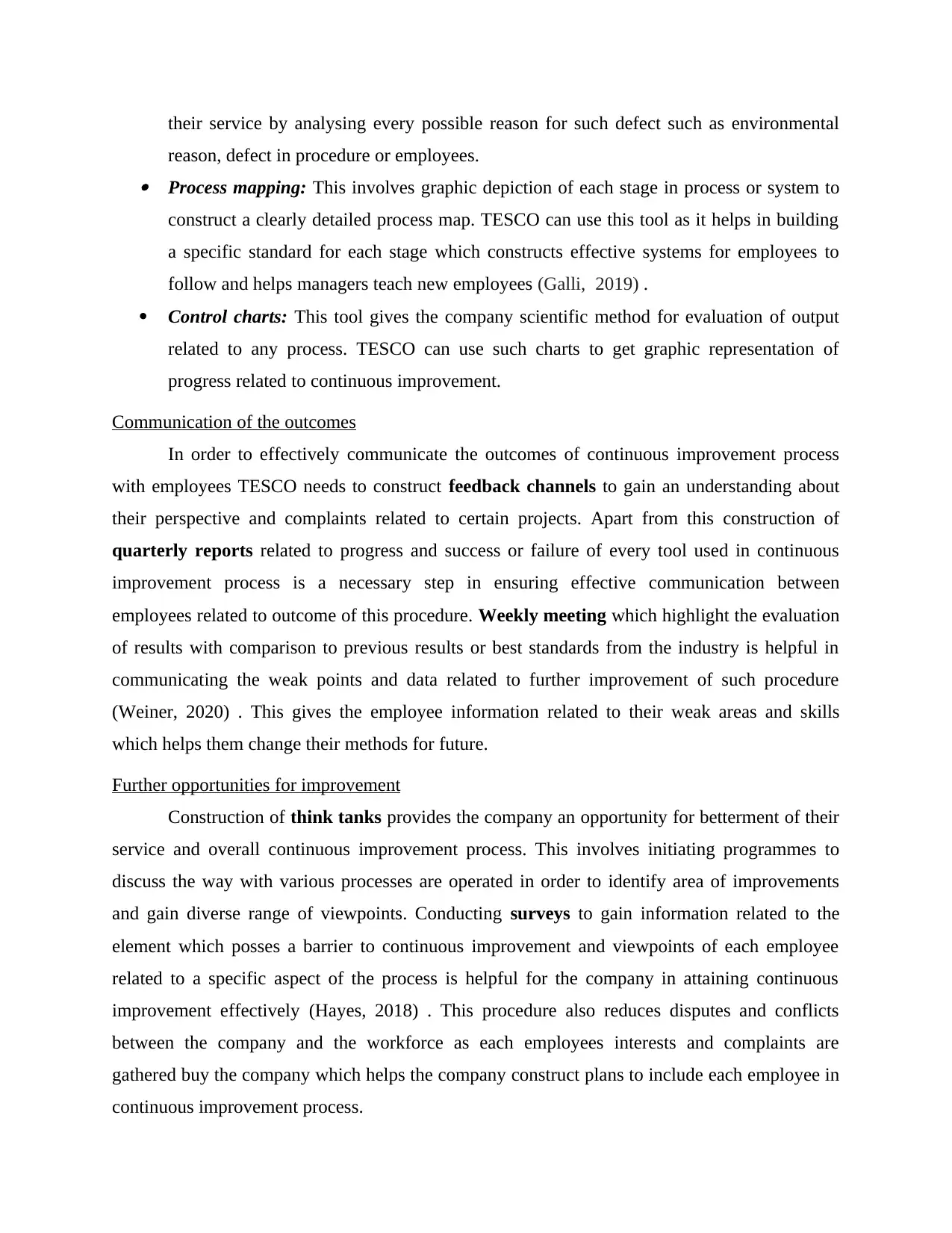
their service by analysing every possible reason for such defect such as environmental
reason, defect in procedure or employees. Process mapping: This involves graphic depiction of each stage in process or system to
construct a clearly detailed process map. TESCO can use this tool as it helps in building
a specific standard for each stage which constructs effective systems for employees to
follow and helps managers teach new employees (Galli, 2019) .
Control charts: This tool gives the company scientific method for evaluation of output
related to any process. TESCO can use such charts to get graphic representation of
progress related to continuous improvement.
Communication of the outcomes
In order to effectively communicate the outcomes of continuous improvement process
with employees TESCO needs to construct feedback channels to gain an understanding about
their perspective and complaints related to certain projects. Apart from this construction of
quarterly reports related to progress and success or failure of every tool used in continuous
improvement process is a necessary step in ensuring effective communication between
employees related to outcome of this procedure. Weekly meeting which highlight the evaluation
of results with comparison to previous results or best standards from the industry is helpful in
communicating the weak points and data related to further improvement of such procedure
(Weiner, 2020) . This gives the employee information related to their weak areas and skills
which helps them change their methods for future.
Further opportunities for improvement
Construction of think tanks provides the company an opportunity for betterment of their
service and overall continuous improvement process. This involves initiating programmes to
discuss the way with various processes are operated in order to identify area of improvements
and gain diverse range of viewpoints. Conducting surveys to gain information related to the
element which posses a barrier to continuous improvement and viewpoints of each employee
related to a specific aspect of the process is helpful for the company in attaining continuous
improvement effectively (Hayes, 2018) . This procedure also reduces disputes and conflicts
between the company and the workforce as each employees interests and complaints are
gathered buy the company which helps the company construct plans to include each employee in
continuous improvement process.
reason, defect in procedure or employees. Process mapping: This involves graphic depiction of each stage in process or system to
construct a clearly detailed process map. TESCO can use this tool as it helps in building
a specific standard for each stage which constructs effective systems for employees to
follow and helps managers teach new employees (Galli, 2019) .
Control charts: This tool gives the company scientific method for evaluation of output
related to any process. TESCO can use such charts to get graphic representation of
progress related to continuous improvement.
Communication of the outcomes
In order to effectively communicate the outcomes of continuous improvement process
with employees TESCO needs to construct feedback channels to gain an understanding about
their perspective and complaints related to certain projects. Apart from this construction of
quarterly reports related to progress and success or failure of every tool used in continuous
improvement process is a necessary step in ensuring effective communication between
employees related to outcome of this procedure. Weekly meeting which highlight the evaluation
of results with comparison to previous results or best standards from the industry is helpful in
communicating the weak points and data related to further improvement of such procedure
(Weiner, 2020) . This gives the employee information related to their weak areas and skills
which helps them change their methods for future.
Further opportunities for improvement
Construction of think tanks provides the company an opportunity for betterment of their
service and overall continuous improvement process. This involves initiating programmes to
discuss the way with various processes are operated in order to identify area of improvements
and gain diverse range of viewpoints. Conducting surveys to gain information related to the
element which posses a barrier to continuous improvement and viewpoints of each employee
related to a specific aspect of the process is helpful for the company in attaining continuous
improvement effectively (Hayes, 2018) . This procedure also reduces disputes and conflicts
between the company and the workforce as each employees interests and complaints are
gathered buy the company which helps the company construct plans to include each employee in
continuous improvement process.
⊘ This is a preview!⊘
Do you want full access?
Subscribe today to unlock all pages.

Trusted by 1+ million students worldwide
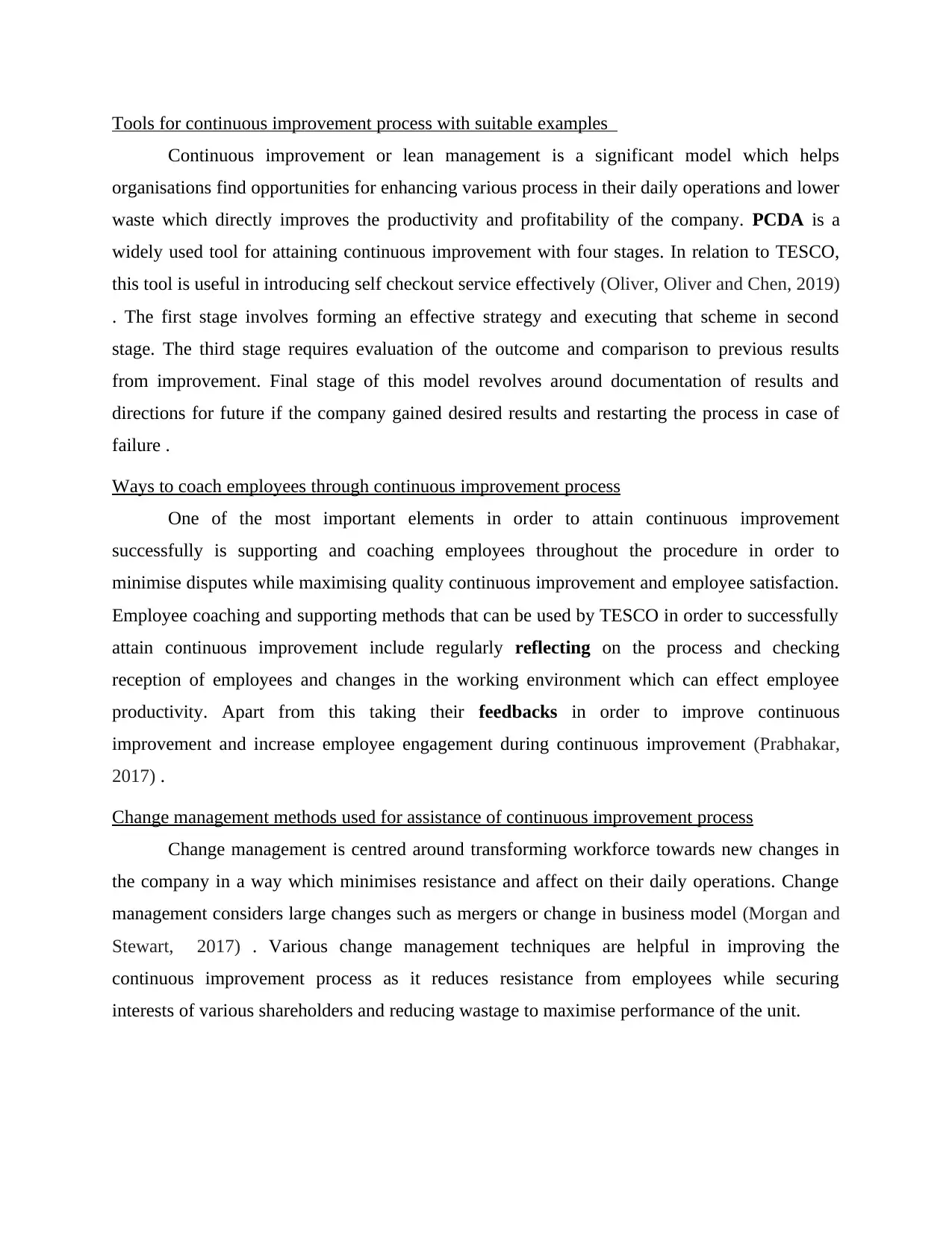
Tools for continuous improvement process with suitable examples
Continuous improvement or lean management is a significant model which helps
organisations find opportunities for enhancing various process in their daily operations and lower
waste which directly improves the productivity and profitability of the company. PCDA is a
widely used tool for attaining continuous improvement with four stages. In relation to TESCO,
this tool is useful in introducing self checkout service effectively (Oliver, Oliver and Chen, 2019)
. The first stage involves forming an effective strategy and executing that scheme in second
stage. The third stage requires evaluation of the outcome and comparison to previous results
from improvement. Final stage of this model revolves around documentation of results and
directions for future if the company gained desired results and restarting the process in case of
failure .
Ways to coach employees through continuous improvement process
One of the most important elements in order to attain continuous improvement
successfully is supporting and coaching employees throughout the procedure in order to
minimise disputes while maximising quality continuous improvement and employee satisfaction.
Employee coaching and supporting methods that can be used by TESCO in order to successfully
attain continuous improvement include regularly reflecting on the process and checking
reception of employees and changes in the working environment which can effect employee
productivity. Apart from this taking their feedbacks in order to improve continuous
improvement and increase employee engagement during continuous improvement (Prabhakar,
2017) .
Change management methods used for assistance of continuous improvement process
Change management is centred around transforming workforce towards new changes in
the company in a way which minimises resistance and affect on their daily operations. Change
management considers large changes such as mergers or change in business model (Morgan and
Stewart, 2017) . Various change management techniques are helpful in improving the
continuous improvement process as it reduces resistance from employees while securing
interests of various shareholders and reducing wastage to maximise performance of the unit.
Continuous improvement or lean management is a significant model which helps
organisations find opportunities for enhancing various process in their daily operations and lower
waste which directly improves the productivity and profitability of the company. PCDA is a
widely used tool for attaining continuous improvement with four stages. In relation to TESCO,
this tool is useful in introducing self checkout service effectively (Oliver, Oliver and Chen, 2019)
. The first stage involves forming an effective strategy and executing that scheme in second
stage. The third stage requires evaluation of the outcome and comparison to previous results
from improvement. Final stage of this model revolves around documentation of results and
directions for future if the company gained desired results and restarting the process in case of
failure .
Ways to coach employees through continuous improvement process
One of the most important elements in order to attain continuous improvement
successfully is supporting and coaching employees throughout the procedure in order to
minimise disputes while maximising quality continuous improvement and employee satisfaction.
Employee coaching and supporting methods that can be used by TESCO in order to successfully
attain continuous improvement include regularly reflecting on the process and checking
reception of employees and changes in the working environment which can effect employee
productivity. Apart from this taking their feedbacks in order to improve continuous
improvement and increase employee engagement during continuous improvement (Prabhakar,
2017) .
Change management methods used for assistance of continuous improvement process
Change management is centred around transforming workforce towards new changes in
the company in a way which minimises resistance and affect on their daily operations. Change
management considers large changes such as mergers or change in business model (Morgan and
Stewart, 2017) . Various change management techniques are helpful in improving the
continuous improvement process as it reduces resistance from employees while securing
interests of various shareholders and reducing wastage to maximise performance of the unit.
Paraphrase This Document
Need a fresh take? Get an instant paraphrase of this document with our AI Paraphraser
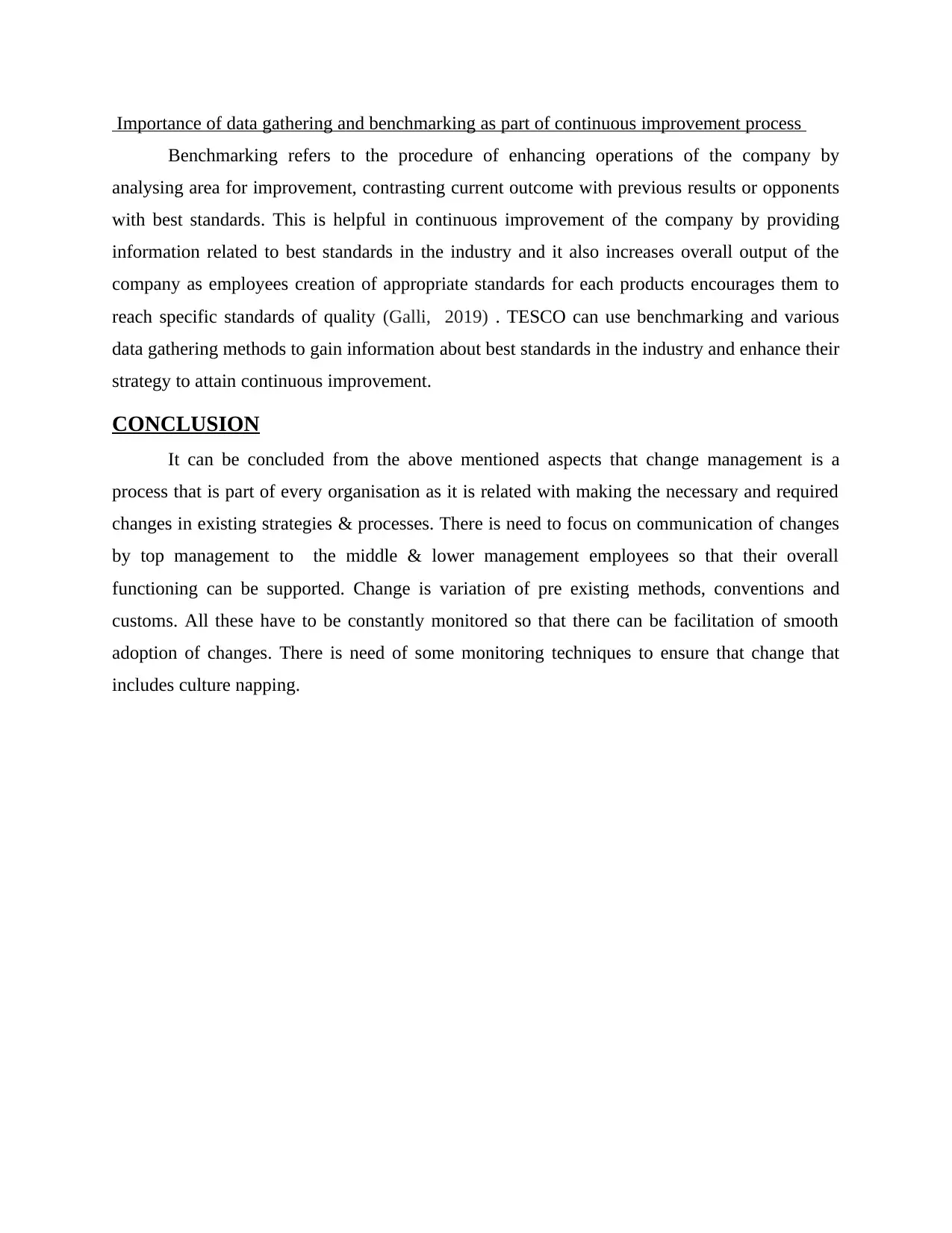
Importance of data gathering and benchmarking as part of continuous improvement process
Benchmarking refers to the procedure of enhancing operations of the company by
analysing area for improvement, contrasting current outcome with previous results or opponents
with best standards. This is helpful in continuous improvement of the company by providing
information related to best standards in the industry and it also increases overall output of the
company as employees creation of appropriate standards for each products encourages them to
reach specific standards of quality (Galli, 2019) . TESCO can use benchmarking and various
data gathering methods to gain information about best standards in the industry and enhance their
strategy to attain continuous improvement.
CONCLUSION
It can be concluded from the above mentioned aspects that change management is a
process that is part of every organisation as it is related with making the necessary and required
changes in existing strategies & processes. There is need to focus on communication of changes
by top management to the middle & lower management employees so that their overall
functioning can be supported. Change is variation of pre existing methods, conventions and
customs. All these have to be constantly monitored so that there can be facilitation of smooth
adoption of changes. There is need of some monitoring techniques to ensure that change that
includes culture napping.
Benchmarking refers to the procedure of enhancing operations of the company by
analysing area for improvement, contrasting current outcome with previous results or opponents
with best standards. This is helpful in continuous improvement of the company by providing
information related to best standards in the industry and it also increases overall output of the
company as employees creation of appropriate standards for each products encourages them to
reach specific standards of quality (Galli, 2019) . TESCO can use benchmarking and various
data gathering methods to gain information about best standards in the industry and enhance their
strategy to attain continuous improvement.
CONCLUSION
It can be concluded from the above mentioned aspects that change management is a
process that is part of every organisation as it is related with making the necessary and required
changes in existing strategies & processes. There is need to focus on communication of changes
by top management to the middle & lower management employees so that their overall
functioning can be supported. Change is variation of pre existing methods, conventions and
customs. All these have to be constantly monitored so that there can be facilitation of smooth
adoption of changes. There is need of some monitoring techniques to ensure that change that
includes culture napping.
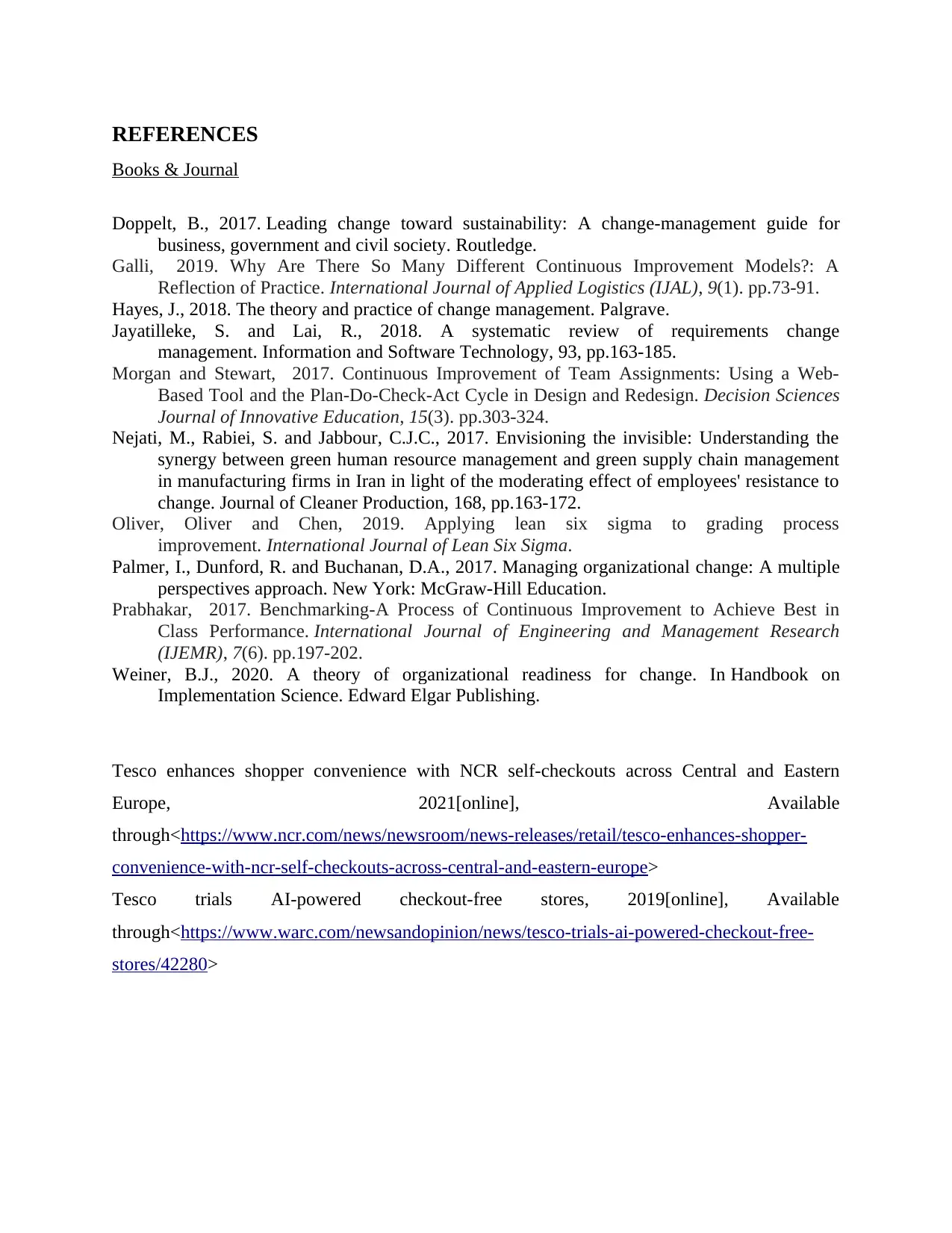
REFERENCES
Books & Journal
Doppelt, B., 2017. Leading change toward sustainability: A change-management guide for
business, government and civil society. Routledge.
Galli, 2019. Why Are There So Many Different Continuous Improvement Models?: A
Reflection of Practice. International Journal of Applied Logistics (IJAL), 9(1). pp.73-91.
Hayes, J., 2018. The theory and practice of change management. Palgrave.
Jayatilleke, S. and Lai, R., 2018. A systematic review of requirements change
management. Information and Software Technology, 93, pp.163-185.
Morgan and Stewart, 2017. Continuous Improvement of Team Assignments: Using a Web‐
Based Tool and the Plan‐Do‐Check‐Act Cycle in Design and Redesign. Decision Sciences
Journal of Innovative Education, 15(3). pp.303-324.
Nejati, M., Rabiei, S. and Jabbour, C.J.C., 2017. Envisioning the invisible: Understanding the
synergy between green human resource management and green supply chain management
in manufacturing firms in Iran in light of the moderating effect of employees' resistance to
change. Journal of Cleaner Production, 168, pp.163-172.
Oliver, Oliver and Chen, 2019. Applying lean six sigma to grading process
improvement. International Journal of Lean Six Sigma.
Palmer, I., Dunford, R. and Buchanan, D.A., 2017. Managing organizational change: A multiple
perspectives approach. New York: McGraw-Hill Education.
Prabhakar, 2017. Benchmarking-A Process of Continuous Improvement to Achieve Best in
Class Performance. International Journal of Engineering and Management Research
(IJEMR), 7(6). pp.197-202.
Weiner, B.J., 2020. A theory of organizational readiness for change. In Handbook on
Implementation Science. Edward Elgar Publishing.
Tesco enhances shopper convenience with NCR self-checkouts across Central and Eastern
Europe, 2021[online], Available
through<https://www.ncr.com/news/newsroom/news-releases/retail/tesco-enhances-shopper-
convenience-with-ncr-self-checkouts-across-central-and-eastern-europe>
Tesco trials AI-powered checkout-free stores, 2019[online], Available
through<https://www.warc.com/newsandopinion/news/tesco-trials-ai-powered-checkout-free-
stores/42280>
Books & Journal
Doppelt, B., 2017. Leading change toward sustainability: A change-management guide for
business, government and civil society. Routledge.
Galli, 2019. Why Are There So Many Different Continuous Improvement Models?: A
Reflection of Practice. International Journal of Applied Logistics (IJAL), 9(1). pp.73-91.
Hayes, J., 2018. The theory and practice of change management. Palgrave.
Jayatilleke, S. and Lai, R., 2018. A systematic review of requirements change
management. Information and Software Technology, 93, pp.163-185.
Morgan and Stewart, 2017. Continuous Improvement of Team Assignments: Using a Web‐
Based Tool and the Plan‐Do‐Check‐Act Cycle in Design and Redesign. Decision Sciences
Journal of Innovative Education, 15(3). pp.303-324.
Nejati, M., Rabiei, S. and Jabbour, C.J.C., 2017. Envisioning the invisible: Understanding the
synergy between green human resource management and green supply chain management
in manufacturing firms in Iran in light of the moderating effect of employees' resistance to
change. Journal of Cleaner Production, 168, pp.163-172.
Oliver, Oliver and Chen, 2019. Applying lean six sigma to grading process
improvement. International Journal of Lean Six Sigma.
Palmer, I., Dunford, R. and Buchanan, D.A., 2017. Managing organizational change: A multiple
perspectives approach. New York: McGraw-Hill Education.
Prabhakar, 2017. Benchmarking-A Process of Continuous Improvement to Achieve Best in
Class Performance. International Journal of Engineering and Management Research
(IJEMR), 7(6). pp.197-202.
Weiner, B.J., 2020. A theory of organizational readiness for change. In Handbook on
Implementation Science. Edward Elgar Publishing.
Tesco enhances shopper convenience with NCR self-checkouts across Central and Eastern
Europe, 2021[online], Available
through<https://www.ncr.com/news/newsroom/news-releases/retail/tesco-enhances-shopper-
convenience-with-ncr-self-checkouts-across-central-and-eastern-europe>
Tesco trials AI-powered checkout-free stores, 2019[online], Available
through<https://www.warc.com/newsandopinion/news/tesco-trials-ai-powered-checkout-free-
stores/42280>
⊘ This is a preview!⊘
Do you want full access?
Subscribe today to unlock all pages.

Trusted by 1+ million students worldwide
1 out of 9
Related Documents
Your All-in-One AI-Powered Toolkit for Academic Success.
+13062052269
info@desklib.com
Available 24*7 on WhatsApp / Email
![[object Object]](/_next/static/media/star-bottom.7253800d.svg)
Unlock your academic potential
Copyright © 2020–2025 A2Z Services. All Rights Reserved. Developed and managed by ZUCOL.





